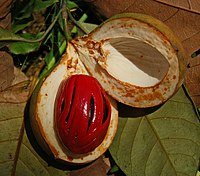
Photo from wikipedia
Abstract Willow branch-shaped MoS2/CdS heterojunctions are successfully synthesized for the first time by a facile one-pot hydrothermal method. The as-prepared samples were characterized by X-ray diffraction, X-ray photoelectron spectroscopy, scanning… Click to show full abstract
Abstract Willow branch-shaped MoS2/CdS heterojunctions are successfully synthesized for the first time by a facile one-pot hydrothermal method. The as-prepared samples were characterized by X-ray diffraction, X-ray photoelectron spectroscopy, scanning electron microscopy, transmission electron microscopy, nitrogen adsorption-desorption measurements, diffuse reflectance spectroscopy, and photoelectrochemical and photoluminescence spectroscopy tests. The photocatalytic hydrogen evolution activities of the samples were evaluated under visible light irradiation. The resulting MoS2/CdS heterojunctions exhibit a much improved photocatalytic hydrogen evolution activity than that obtained with CdS and MoS2. In particular, the optimized MC-5 (5 at.% MoS2/CdS) photocatalyst achieved the highest hydrogen production rate of 250.8 μmol h-1, which is 28 times higher than that of pristine CdS. The apparent quantum efficiency (AQE) at 420 nm was 3.66%. Further detailed characterizations revealed that the enhanced photocatalytic activity of the MoS2/CdS heterojunctions could be attributed to the efficient transfer and separation of photogenerated charge carriers resulting from the core-shell structure and the close contact between MoS2 nanosheets and CdS single-crystal nanorods, as well as to increased visible light absorption. A tentative mechanism for photocatalytic H2 evolution by MoS2/CdS heterojunctions was proposed. This work will open up new opportunities for developing more efficient photocatalysts for water splitting.
Journal Title: Chinese Journal of Catalysis
Year Published: 2019
Link to full text (if available)
Share on Social Media: Sign Up to like & get
recommendations!